warning light VAUXHALL ZAFIRA TOURER 2016 Owner's Guide
[x] Cancel search | Manufacturer: VAUXHALL, Model Year: 2016, Model line: ZAFIRA TOURER, Model: VAUXHALL ZAFIRA TOURER 2016Pages: 305, PDF Size: 9.15 MB
Page 203 of 305
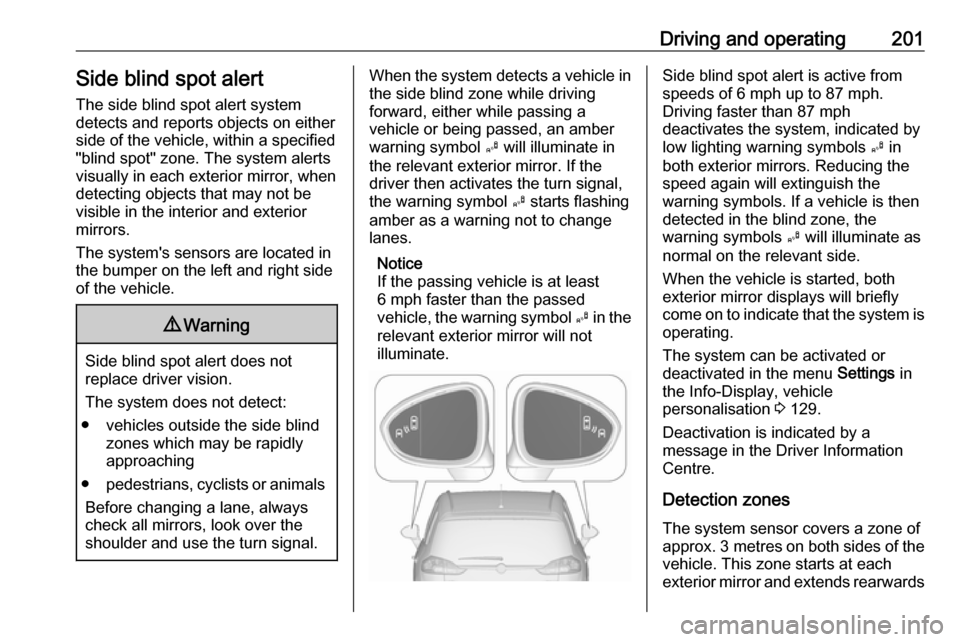
Driving and operating201Side blind spot alertThe side blind spot alert system
detects and reports objects on either
side of the vehicle, within a specified
"blind spot" zone. The system alerts
visually in each exterior mirror, when
detecting objects that may not be
visible in the interior and exterior
mirrors.
The system's sensors are located in
the bumper on the left and right side
of the vehicle.9 Warning
Side blind spot alert does not
replace driver vision.
The system does not detect:
● vehicles outside the side blind zones which may be rapidly
approaching
● pedestrians, cyclists or animals
Before changing a lane, always
check all mirrors, look over the
shoulder and use the turn signal.
When the system detects a vehicle in the side blind zone while driving
forward, either while passing a
vehicle or being passed, an amber
warning symbol B will illuminate in
the relevant exterior mirror. If the
driver then activates the turn signal,
the warning symbol B starts flashing
amber as a warning not to change
lanes.
Notice
If the passing vehicle is at least
6 mph faster than the passed
vehicle, the warning symbol B in the
relevant exterior mirror will not
illuminate.Side blind spot alert is active from
speeds of 6 mph up to 87 mph.
Driving faster than 87 mph
deactivates the system, indicated by
low lighting warning symbols B in
both exterior mirrors. Reducing the speed again will extinguish the
warning symbols. If a vehicle is then
detected in the blind zone, the
warning symbols B will illuminate as
normal on the relevant side.
When the vehicle is started, both exterior mirror displays will briefly
come on to indicate that the system is operating.
The system can be activated or
deactivated in the menu Settings in
the Info-Display, vehicle
personalisation 3 129.
Deactivation is indicated by a
message in the Driver Information
Centre.
Detection zones The system sensor covers a zone of
approx. 3 metres on both sides of the
vehicle. This zone starts at each
exterior mirror and extends rearwards
Page 205 of 305
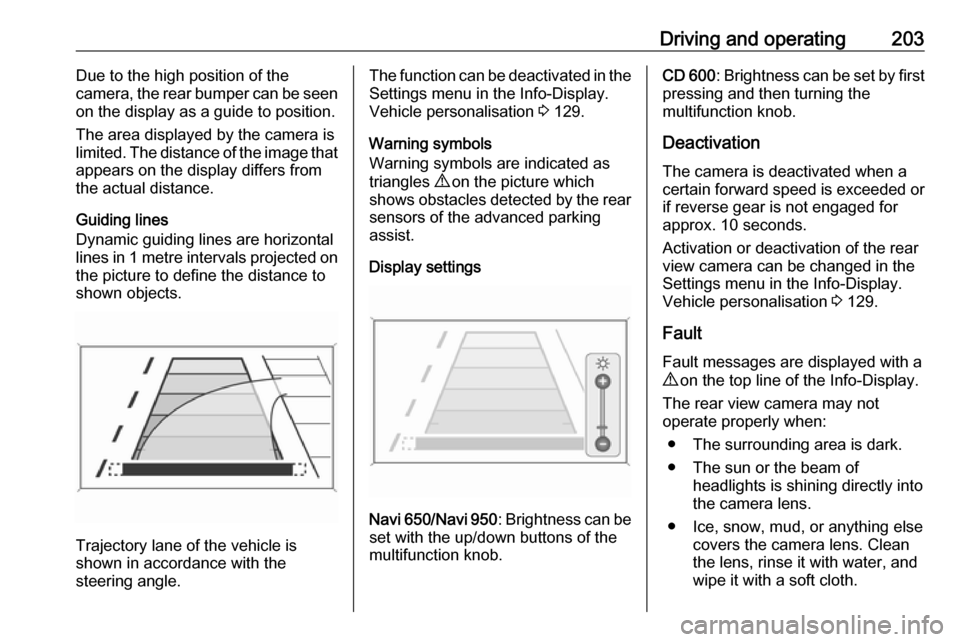
Driving and operating203Due to the high position of the
camera, the rear bumper can be seen
on the display as a guide to position.
The area displayed by the camera is
limited. The distance of the image that
appears on the display differs from
the actual distance.
Guiding lines
Dynamic guiding lines are horizontal
lines in 1 metre intervals projected on
the picture to define the distance to
shown objects.
Trajectory lane of the vehicle is
shown in accordance with the
steering angle.
The function can be deactivated in the
Settings menu in the Info-Display.
Vehicle personalisation 3 129.
Warning symbols
Warning symbols are indicated as
triangles 9 on the picture which
shows obstacles detected by the rear sensors of the advanced parking
assist.
Display settings
Navi 650 /Navi 950 : Brightness can be
set with the up/down buttons of the
multifunction knob.
CD 600 : Brightness can be set by first
pressing and then turning the
multifunction knob.
Deactivation The camera is deactivated when a
certain forward speed is exceeded or
if reverse gear is not engaged for
approx. 10 seconds.
Activation or deactivation of the rear
view camera can be changed in the Settings menu in the Info-Display.
Vehicle personalisation 3 129.
Fault
Fault messages are displayed with a
9 on the top line of the Info-Display.
The rear view camera may not
operate properly when:
● The surrounding area is dark.
● The sun or the beam of headlights is shining directly into
the camera lens.
● Ice, snow, mud, or anything else covers the camera lens. Clean
the lens, rinse it with water, and
wipe it with a soft cloth.
Page 209 of 305
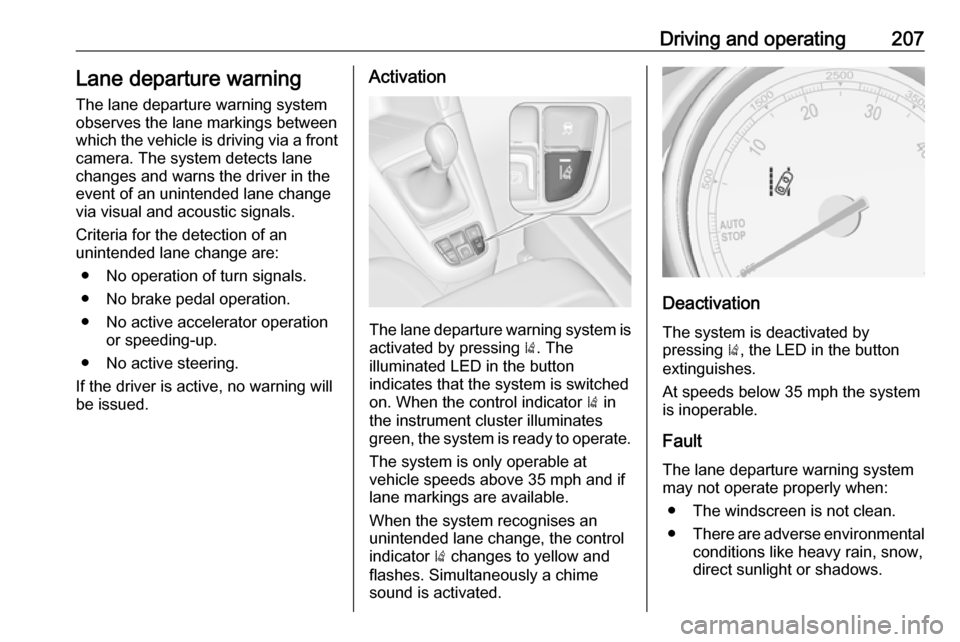
Driving and operating207Lane departure warningThe lane departure warning system
observes the lane markings between
which the vehicle is driving via a front
camera. The system detects lane
changes and warns the driver in the
event of an unintended lane change
via visual and acoustic signals.
Criteria for the detection of an
unintended lane change are:
● No operation of turn signals.
● No brake pedal operation.
● No active accelerator operation or speeding-up.
● No active steering.
If the driver is active, no warning will
be issued.Activation
The lane departure warning system is activated by pressing ). The
illuminated LED in the button
indicates that the system is switched
on. When the control indicator ) in
the instrument cluster illuminates
green, the system is ready to operate.
The system is only operable at
vehicle speeds above 35 mph and if
lane markings are available.
When the system recognises an
unintended lane change, the control
indicator ) changes to yellow and
flashes. Simultaneously a chime
sound is activated.
Deactivation
The system is deactivated by
pressing ), the LED in the button
extinguishes.
At speeds below 35 mph the system
is inoperable.
Fault
The lane departure warning system
may not operate properly when:
● The windscreen is not clean.
● There are adverse environmental
conditions like heavy rain, snow,
direct sunlight or shadows.
Page 213 of 305
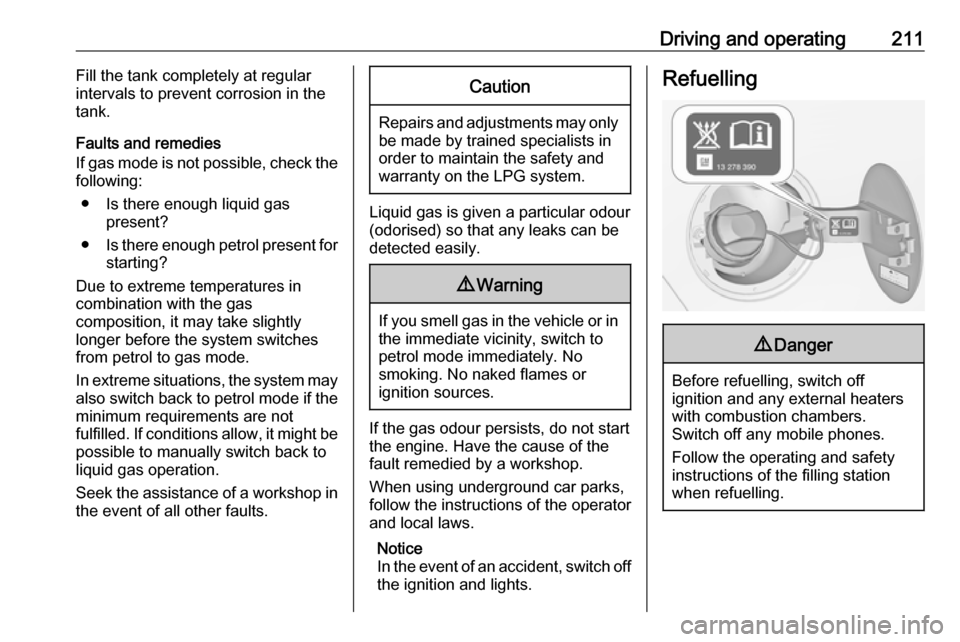
Driving and operating211Fill the tank completely at regular
intervals to prevent corrosion in the
tank.
Faults and remedies
If gas mode is not possible, check the
following:
● Is there enough liquid gas present?
● Is there enough petrol present for
starting?
Due to extreme temperatures in
combination with the gas
composition, it may take slightly
longer before the system switches
from petrol to gas mode.
In extreme situations, the system may also switch back to petrol mode if the
minimum requirements are not
fulfilled. If conditions allow, it might be
possible to manually switch back to
liquid gas operation.
Seek the assistance of a workshop in the event of all other faults.Caution
Repairs and adjustments may onlybe made by trained specialists in
order to maintain the safety and
warranty on the LPG system.
Liquid gas is given a particular odour
(odorised) so that any leaks can be
detected easily.
9 Warning
If you smell gas in the vehicle or in
the immediate vicinity, switch to petrol mode immediately. No
smoking. No naked flames or
ignition sources.
If the gas odour persists, do not start
the engine. Have the cause of the
fault remedied by a workshop.
When using underground car parks,
follow the instructions of the operator
and local laws.
Notice
In the event of an accident, switch off
the ignition and lights.
Refuelling9 Danger
Before refuelling, switch off
ignition and any external heaters
with combustion chambers.
Switch off any mobile phones.
Follow the operating and safety
instructions of the filling station
when refuelling.
Page 215 of 305
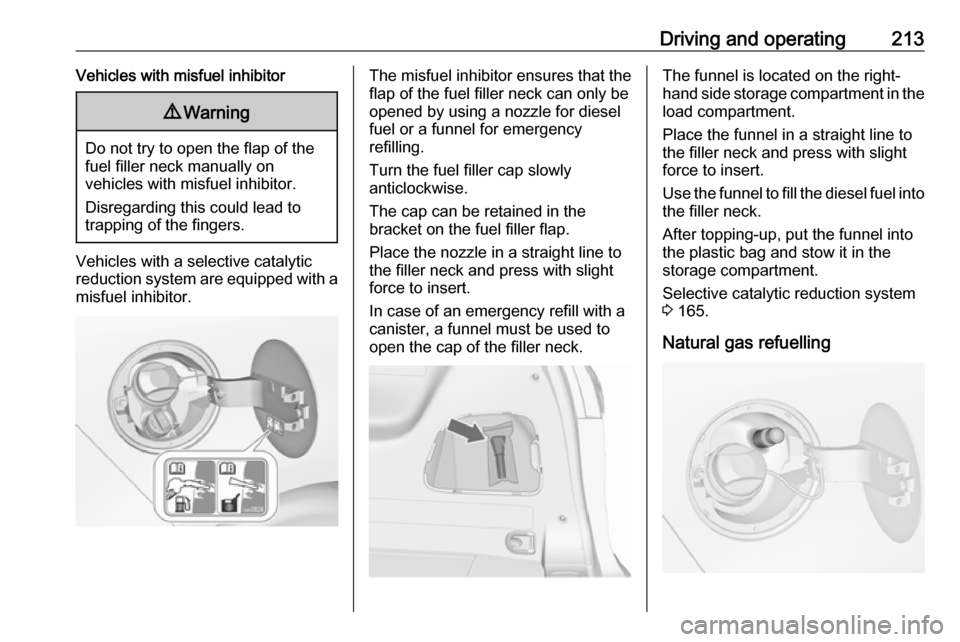
Driving and operating213Vehicles with misfuel inhibitor9Warning
Do not try to open the flap of the
fuel filler neck manually on
vehicles with misfuel inhibitor.
Disregarding this could lead to
trapping of the fingers.
Vehicles with a selective catalytic
reduction system are equipped with a
misfuel inhibitor.
The misfuel inhibitor ensures that the flap of the fuel filler neck can only be
opened by using a nozzle for diesel
fuel or a funnel for emergency
refilling.
Turn the fuel filler cap slowly
anticlockwise.
The cap can be retained in the
bracket on the fuel filler flap.
Place the nozzle in a straight line to the filler neck and press with slight
force to insert.
In case of an emergency refill with a
canister, a funnel must be used to
open the cap of the filler neck.The funnel is located on the right-
hand side storage compartment in the load compartment.
Place the funnel in a straight line to
the filler neck and press with slight force to insert.
Use the funnel to fill the diesel fuel into
the filler neck.
After topping-up, put the funnel into
the plastic bag and stow it in the storage compartment.
Selective catalytic reduction system
3 165.
Natural gas refuelling
Page 226 of 305
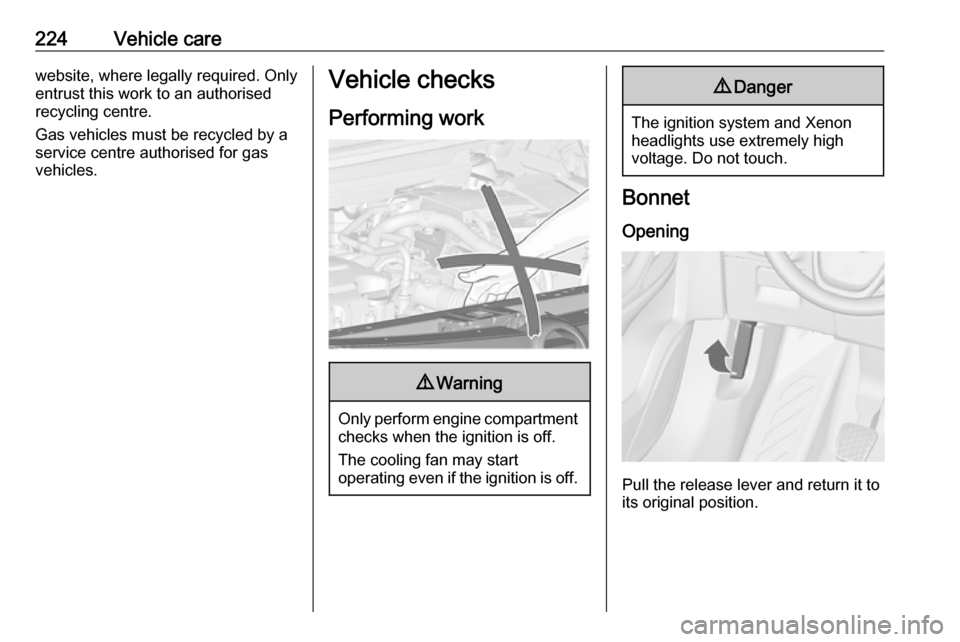
224Vehicle carewebsite, where legally required. Only
entrust this work to an authorised
recycling centre.
Gas vehicles must be recycled by a
service centre authorised for gas
vehicles.Vehicle checks
Performing work9 Warning
Only perform engine compartment
checks when the ignition is off.
The cooling fan may start
operating even if the ignition is off.
9 Danger
The ignition system and Xenon
headlights use extremely high
voltage. Do not touch.
Bonnet
Opening
Pull the release lever and return it to
its original position.
Page 232 of 305
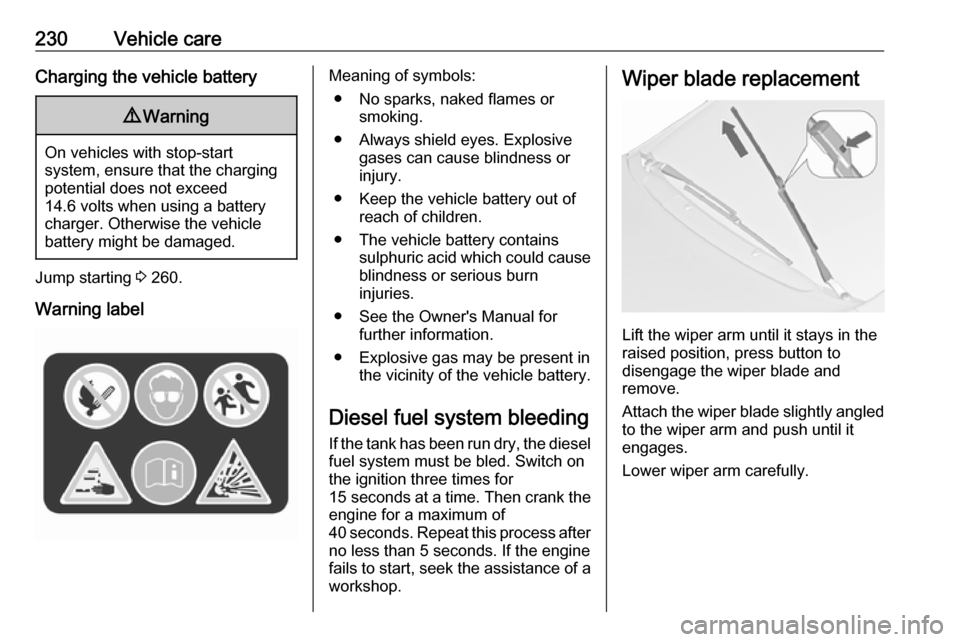
230Vehicle careCharging the vehicle battery9Warning
On vehicles with stop-start
system, ensure that the charging potential does not exceed
14.6 volts when using a battery
charger. Otherwise the vehicle
battery might be damaged.
Jump starting 3 260.
Warning label
Meaning of symbols: ● No sparks, naked flames or smoking.
● Always shield eyes. Explosive gases can cause blindness or
injury.
● Keep the vehicle battery out of reach of children.
● The vehicle battery contains sulphuric acid which could cause
blindness or serious burn
injuries.
● See the Owner's Manual for further information.
● Explosive gas may be present in the vicinity of the vehicle battery.
Diesel fuel system bleeding If the tank has been run dry, the diesel
fuel system must be bled. Switch on
the ignition three times for
15 seconds at a time. Then crank the
engine for a maximum of 40 seconds. Repeat this process after
no less than 5 seconds. If the engine fails to start, seek the assistance of a
workshop.Wiper blade replacement
Lift the wiper arm until it stays in the
raised position, press button to
disengage the wiper blade and
remove.
Attach the wiper blade slightly angled
to the wiper arm and push until it
engages.
Lower wiper arm carefully.
Page 251 of 305
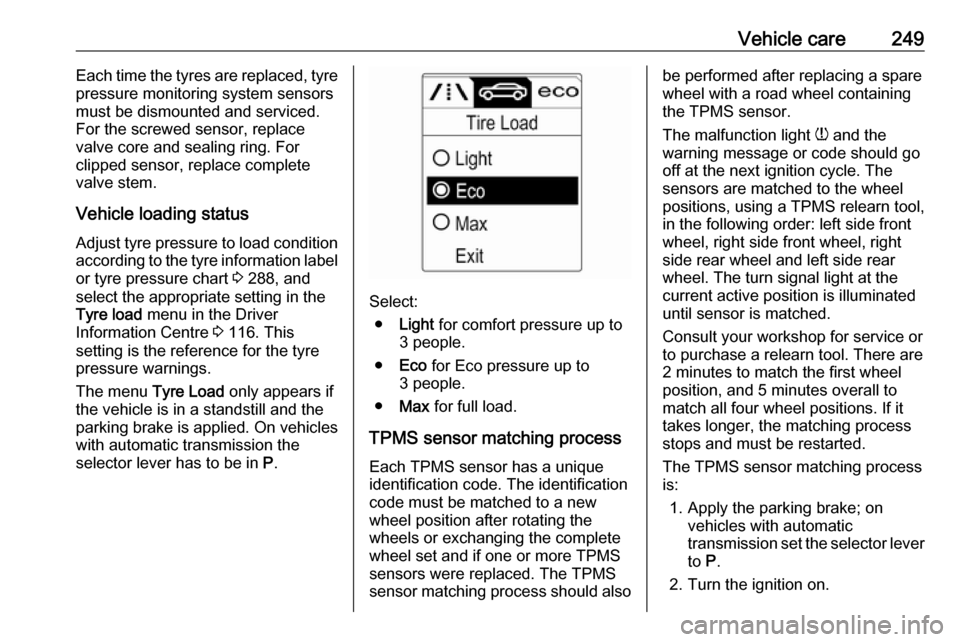
Vehicle care249Each time the tyres are replaced, tyre
pressure monitoring system sensors
must be dismounted and serviced. For the screwed sensor, replace
valve core and sealing ring. For
clipped sensor, replace complete
valve stem.
Vehicle loading status
Adjust tyre pressure to load condition according to the tyre information labelor tyre pressure chart 3 288, and
select the appropriate setting in the
Tyre load menu in the Driver
Information Centre 3 116. This
setting is the reference for the tyre
pressure warnings.
The menu Tyre Load only appears if
the vehicle is in a standstill and the
parking brake is applied. On vehicles
with automatic transmission the
selector lever has to be in P.
Select:
● Light for comfort pressure up to
3 people.
● Eco for Eco pressure up to
3 people.
● Max for full load.
TPMS sensor matching process Each TPMS sensor has a unique
identification code. The identification
code must be matched to a new
wheel position after rotating the
wheels or exchanging the complete
wheel set and if one or more TPMS
sensors were replaced. The TPMS sensor matching process should also
be performed after replacing a spare
wheel with a road wheel containing
the TPMS sensor.
The malfunction light w and the
warning message or code should go
off at the next ignition cycle. The
sensors are matched to the wheel
positions, using a TPMS relearn tool,
in the following order: left side front
wheel, right side front wheel, right
side rear wheel and left side rear
wheel. The turn signal light at the
current active position is illuminated
until sensor is matched.
Consult your workshop for service or
to purchase a relearn tool. There are
2 minutes to match the first wheel
position, and 5 minutes overall to
match all four wheel positions. If it
takes longer, the matching process
stops and must be restarted.
The TPMS sensor matching process
is:
1. Apply the parking brake; on vehicles with automatic
transmission set the selector lever
to P.
2. Turn the ignition on.
Page 301 of 305

299Child restraint systems ................60
Cigarette lighter .........................103
Climate control ............................. 15
Climate control systems .............150
Clock........................................... 101
Code ........................................... 122
Control indicators........................ 107
Control of the vehicle .................159
Controls ........................................ 97
Convex shape .............................. 28
Coolant and antifreeze ...............270
Cruise control ....................116, 179
Cupholders .................................. 67
Curtain airbag system .................. 58
Curve lighting.............................. 142
D Danger, Warnings and Cautions ...4
Daytime running lights ...............142
Declaration of conformity ............292
DEF ............................................ 165
Diesel exhaust fluid ....................165
Diesel fuel system bleeding .......230
Diesel particle filter .............114, 164
Door open .................................. 116
Door panel storage .......................68
Doors ............................................ 25
Driver assistance systems ..........179
Driver Information Centre ...........116Driving characteristics and
towing tips .............................. 218
Driving hints ................................ 159
E Electric adjustment ......................28
Electrical system......................... 239
Electric parking brake .........112, 173
Electric parking brake fault .........112
Electronic climate control system 152
Electronic driving programmes ..170
Electronic Stability Control.......... 176
Electronic Stability Control and Traction Control system ..........113
Electronic Stability Control off..... 113
End-of-life vehicle recovery .......223
Engine compartment fuse box ...240
Engine coolant ........................... 226
Engine coolant temperature gauge ..................................... 106
Engine data ............................... 277
Engine exhaust .......................... 164
Engine identification ...................273
Engine oil ................... 225, 270, 274
Engine oil pressure ....................114
Entry lighting .............................. 148
Event data recorders ..................296
Exit lighting ................................ 149
Exterior care .............................. 264
Exterior light ............................... 115Exterior lighting ....................12, 138
Exterior mirrors ............................. 28
F
Fault ........................................... 171
First aid kit ................................... 92
Fixed air vents ........................... 157
Flex-Fix system ............................ 70
Fog light ..................................... 116
Fog lights ................................... 234
Folding mirrors ............................. 29
Folding tray .................................. 92
Following distance indication ......192
Forward collision alert................. 188
Front airbag system .....................57
Front fog lights ........................... 146
Front seats.................................... 38
Front storage ................................ 68
Fuel............................................. 208
Fuel consumption - CO 2-
Emissions ............................... 216
Fuel for diesel engines ..............208
Fuel for liquid gas operation .......209
Fuel for natural gas operation ...209
Fuel for petrol engines ...............208
Fuel gauge ................................. 105
Fuel selector .............................. 105
Fuses ......................................... 239
Page 302 of 305

300GGauges ....................................... 104
General information ...................217
Glass panel .................................. 34
Glovebox ..................................... 66
Graphic-Info-Display, Colour- Info-Display ............................ 120
H Halogen headlights ....................231
Hand brake ......................... 172, 173
Hazard warning flashers ............145
Headlight flash ........................... 140
Headlight range adjustment ......141
Headlights................................... 138
Headlights when driving abroad 141
Head restraint adjustment .............8
Head restraints ............................ 36
Heated mirrors ............................. 29
Heated rear window ..................... 33
Heated steering wheel .................97
Heating ........................................ 43
Heating and ventilation system . 150
High beam ......................... 115, 140
High beam assist ................115, 140
Hill start assist ........................... 175
Horn ....................................... 13, 98
I
Identification plate .....................272
Ignition switch positions .............160Immobiliser .......................... 28, 115
Indicators .................................... 104
Information displays.................... 116
Instrument cluster ......................104
Instrument panel fuse box .........242
Instrument panel illumination .....239
Instrument panel illumination control .................................... 147
Instrument panel overview ........... 10
Instrument panel storage ..............66
Interactive driving system ...........177
Interior care ............................... 266
Interior lighting ............................ 147
Interior lights ...................... 147, 238
Interior mirrors .............................. 30
Interruption of power supply ......171
Introduction .................................... 3
ISOFIX child restraint systems ....65
J Jump starting ............................. 260
K Keys ............................................. 19
Keys, locks ................................... 19
L
Lane departure warning .....113, 207
Lashing eyes ............................... 88
Lighting features .........................148
Light switch ................................ 138Load compartment ................25, 79
Load compartment cover .............82
Load compartment fuse box ......243
Loading information .....................94
Load rails and hooks ...................88
Low fuel ..................................... 115
Low washer fluid ........................116
M Malfunction indicator light ..........111
Manual anti-dazzle ......................30
Manual mode ............................. 170
Manual transmission .................. 172
Manual windows ..........................31
Memorised settings ......................23
Mirror adjustment ........................... 9
Misted light covers .....................147
N New vehicle running-in ..............159
Number plate light .....................238
O
Object detection systems ...........194
Odometer ................................... 104
Oil, engine .................. 225, 270, 274
OnStar ........................................ 133
Operate pedal ............................. 112
Outside temperature ..................100
Overhead console .......................68
Overrun cut-off ........................... 161